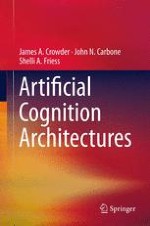2014 | OriginalPaper | Chapter
7. Learning in an Artificial Cognitive System
Authors : James A. Crowder, John N. Carbone, Shelli A. Friess
Published in: Artificial Cognition Architectures
Publisher: Springer New York
Activate our intelligent search to find suitable subject content or patents.
Select sections of text to find matching patents with Artificial Intelligence. powered by
Select sections of text to find additional relevant content using AI-assisted search. powered by
